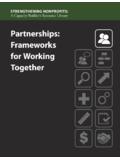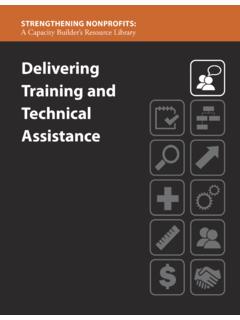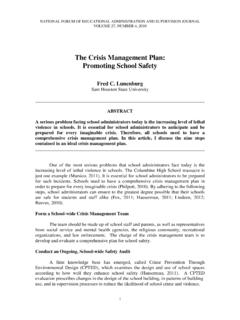Transcription of Managing Crisis - Strengthening Nonprofits:
1 Strengthening NONPROFITS: A Capacity Builder's Resource Library Managing Crisis : Risk management and Crisis Response Planning TABLE OF CONTENTS. 3. 4. Key 4. RISK management IN NONPROFIT 5. What Could Go Wrong? .. 5. What Will You Do to Prevent Things from Going Wrong?.. 6. Crisis RESPONSE PLANNING IN NONPROFIT 7. What Will You Do if Something Goes Wrong?.. 7. RESPONDING TO A Crisis IN NONPROFIT 8. NONPROFIT RISK AND Crisis VULNERABILITIES .. 10. Significant 11. Loss or Damage of Physical 15. Loss of Human 17. Employee 19. 22. 23. APPENDIX A: Works APPENDIX B: Additional APPENDIX C: Assembling a Crisis management 27. APPENDIX D: Best- and Worst-Case Scenario APPENDIX E: Situational INTRODUCTION. The Compassion Capital Fund (CCF), administered by the Department of Health and Human Services, provided capacity building grants to expand and strengthen the role of nonprofit organizations in their ability to provide social services to low-income individuals.
2 Between 2002 and 2009, CCF awarded 1,277 grants, and the CCF National Resource Center provided training and technical assistance to all CCF grantees. Strengthening Nonprofits: A Capacity Builder's Resource Library is born out of the expansive set of resources created by the National Resource Center during that time period, to be shared and to continue the legacy of CCF's capacity building work. Strengthening Nonprofits: A Capacity Builder's Resource Library contains guidebooks and e-learnings on the following topics: 1. Conducting a Community Assessment 2. Delivering Training and Technical Assistance 3. Designing and Managing a Subaward Program 4. Going Virtual 5. Identifying and Promoting Effective Practices 6. Leading a Nonprofit Organization: Tips and Tools for Executive Directors and Team Leaders 7. Managing Crisis : Risk management and Crisis Response Planning 8.
3 Managing Public Grants 9. Measuring Outcomes 10. Partnerships: Frameworks for Working Together 11. Sustainability 12. Working with Consultants Who is the audience for Strengthening Nonprofits: A Capacity Builder's Resource Library? Anyone who is interested in expanding the capacity of nonprofit services in their community from front . line service providers to executives in large intermediary organizations will benefit from the information contained in this resource library. The National Resource Center originally developed many of these resources for intermediary organizations, organizations that were granted funds by CCF to build the capacity of the faith-based and community-based organizations (FBCOs) they served. As such, the majority of the resources in Strengthening Nonprofits: A Capacity Builder's Resource Library support intermediary organizations in their capacity building efforts.
4 However, funders of capacity building programs (Federal program offices and foundations) and the nonprofit community (including FBCOs) at large will also find these resources helpful. In addition, individuals working to build capacity within a program or an organization will be able to use these resources to support their efforts to implement change and make improvements. The Managing Crisis guidebook will be helpful to anyone in a leadership role in an organization planning for or currently experiencing Crisis situations. Who developed the Managing Crisis guidebook? The guidebook was developed for the Department of Health and Human Services by the National Resource Center. 3. OVERVIEW. Preparing for Crisis situations and responding appropriately to them if they occur can mean the difference between closure and survival, or even flourishing.
5 After all, crises can be fertile opportunities for learning and change if an organization is equipped with the right tools to handle them. There are two sides to Managing any Crisis : planning and response. Organizations that anticipate the possibility of a Crisis and prepare properly will be better equipped to manage such situations or avoid them altogether. This guidebook addresses three key questions to help guide your risk management and Crisis response planning1: 1. What could go wrong? 2. What will you do to prevent things from going wrong? 3. What will you do if something goes wrong? The guidebook reviews the importance of risk management for identifying Crisis priorities in nonprofit organizations and offers suggestions for developing a Crisis response plan and a Crisis communication plan. Additionally, the guide highlights four specific areas in which nonprofit organizations are vulnerable to risk and Crisis .
6 You will find more resources to help support your risk management and Crisis response planning in Appendix B. Key Terms2. Risk any factor that might hinder an organization achieving its goals. Risks can be related to an organization's programs, finances, management , infrastructure, or susceptibility to natural disasters. Risk management a process for identifying an organization's risks, assessing their significance, and preparing for and treating those deemed significant in a measured, professional manner. Risk management enables organizations to cope with uncertainty by taking steps to protect their vital assets and Crisis a risk characterized by an event, revelation, allegation, or set of circumstances that threatens the integrity, reputation, or survival of an individual or an institution. 4. Crisis response an approach to dealing with an event in a professional manner that addresses the critical needs of the time.
7 The focus is on surviving the Crisis in progress and easing the effects of the Crisis as much as possible. Also referred to as Crisis management . 1 Nonprofit Risk management Center, No Surprises Volunteer Risk management Tutorial, tools/ 2 Adapted from Risk and Crisis management for Schools: Austega's Guide for School Leaders, Austega Information Services, 3 Nonprofit Risk management Center, Risk management Tutorial for Nonprofit Managers, basic- 4 Bates Communication, The CEO Survival Guide Crisis Communications Media Interviews, 4. RISK management IN NONPROFIT ORGANIZATIONS. What Could Go Wrong? There are many events that can throw an organization into Crisis . When that organization is a nonprofit, which is often less resource-rich than its for-profit counterparts, the results can be devastating. A key donor goes bankrupt.
8 An office is flooded. An employee is caught embezzling. A program space is condemned. These examples highlight the reality that risk and Crisis are often related. For example, lax financial management controls create an environment that can lead to embezzlement. Delayed repairs to save money can lead to unsafe program space. In both instances an organization created a risk that resulted in a Crisis . Another reality is that most nonprofit organizations are engaged in work that is inherently risky; the risks come with the work. Organizations working with children, the elderly, and other vulnerable populations must constantly find ways to ensure that their clients are protected. Organizations that bring large numbers of people together must focus on safety and injury prevention. Some organizations take clients on trips or work locations and must address transportation risks.
9 If organizations do not prepare for their inherent risks, they increase their chances for crises to occur. Even events with positive benefits can turn negative due to poor planning:5. Twice as many walk-in volunteers as expected show up to help and you have no plan to put them to work or capture their enthusiasm for a future project. You're overwhelmed with perishable donations in response to a community plea, but you have no procedures in place for handling the overflow in a timely and equitable manner. You plan an event to give away items for free but run out of the items midway through the event. Managing risk anything that can hinder an organization from achieving its goals is an essential management activity for nonprofit organizations. Nonprofits tend to focus their risk management on the following activities:6. Screening volunteers to protect clients from harm Checking motor vehicle records for all employees and volunteers driving on the nonprofit's behalf Developing board orientation and training materials Developing and consistently using employment practices Negotiating the availability of bank credit and purchasing property and liability insurance to address the organization's principal exposures Addressing hazards associated with the organization's fundraising events Recommending policies and procedures that insulate the organization from liability when it enters into relationships with partner or affiliate organizations This list is not exhaustive.
10 There may be other areas in which your organization has risks. 5 Nonprofit Risk management Center, Mission Controls Fact Sheets on Crisis management : Crisis management Essentials, . 6 Alliance for Nonprofit management , Risk management , 5. What Will You Do to Prevent Things from Going Wrong? Stakeholders expect that you will protect program participants, volunteers, staff, and property. They expect you to appropriately manage funds and resources. They expect your actions to uphold the organization's reputation. Risk management planning demonstrates that your organization is proactively taking steps to meet these expectations. There are seven key steps to a risk management planning 1. Establish the purpose or context for risk management planning. Clearly state why your organization needs to focus on risk management . Perhaps there have been too many close calls and crises were averted due to the quick thinking of staff.








